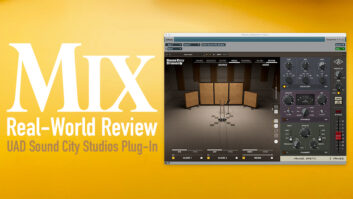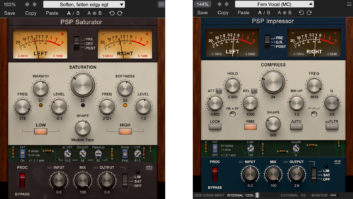
“I can’t have a conversation about my occupation or my latest projects without it sounding like I’m name-dropping,” writes Grammy-winning producer, engineer and mixer Mark Howard in the introduction to his book, Listen Up! Indeed, the book, written with his brother, Chris Howard, lists just a few of those names in its subtitle: Recording Music with Bob Dylan, Neil Young, U2, R.E.M., The Tragically Hip, Red Hot Chili Peppers, Tom Waits…
Born in Manchester, England, and moving with his family to Canada at a very young age, Howard dropped out of school at 16 and fell into music, mixing bands in local clubs and learning to play the drums. After injuring his back in a serious motorbike accident, he found work at Grant Avenue Studio in his hometown of Hamilton, Ontario. It was there that he met musician and producer Daniel Lanois, working on his Acadie solo album. The pair would collaborate for nearly a quarter century.
Chapter 1 drops the reader into New Orleans in 1988, during production of the Neville Brothers’ Yellow Moon album, produced by Lanois and engineered by Howard. At that time, artists were still largely booking extended periods of time at commercial studios to record their albums. Lanois and Howard favored a different approach, temporarily setting up a studio for months or even years at a location that could also house everyone involved. “Something about everyone being in close proximity for a period of time encourages the creative flow,” Howard writes.
Related: Making Rumors: The Inside Story of the Classic Fleetwood Mac Album, by Clive Young, Sep. 17, 2012
At each successive location, Howard would rent or buy a large, typically multistory building, set up accommodations for everyone, furnish the rooms to create the right vibe, and move in the recording gear. At times, Listen Up! reads like Lifestyles of the Rich and Famous, as he casually mentions some of the purchases: a car here, a mixing console there, a string of vintage motorbikes (he and Lanois owned a dozen between them at one point).
In the early days, anyway, the funds came from Lanois, with whom Howard has obviously had a prickly relationship, taking numerous jabs at him throughout the book. While setting up Kingsway Studio in New Orleans in 1989, Howard writes, Lanois was paying him $200 a week and having him dilute the apple juice to make it stretch twice as far, yet he happily dropped $70,000 on a new guitar.
There is a ton of information for equipment aficionados—not just what gear was installed at which studio but also specifics from each session. Once the pair moved on from Kingsway Studio and New Orleans, they began to favor a single-room layout. “I’ve spent my life recording in almost every imaginable space and I always get the best results when I put the recording equipment in the studio,” Howard states. “Any time I do a record in a traditional studio, I end up with the band in the control room, even the drums.”
Want more stories like this? Subscribe to our newsletter and get it delivered right to your inbox.
Bob Dylan features prominently and is notable for acknowledging Howard’s role in the making of his records. Picking up one of three Grammys for Time Out of Mind, largely produced at Teatro, the studio Howard built in a former movie house in Oxnard, CA, Dylan thanked him and said, “It’s not every day that you get a sound like this.”
Howard either has exceptional recall or kept a detailed diary because the book is chock full of anecdotes from the sessions, offering fascinating insight into the creative process of each artist. “Each artistic endeavor had its own drama,” he writes, noting the turbulent relationships, fights and self-doubt. “To work successfully in the music business, you need to be willing to ride those waves of turmoil to get to the masterpiece waiting on the beach.”
ECW Press • www.ecwpress.com







